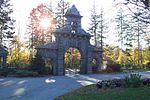United States Cartridge Company

The United States Cartridge Company was an early manufacturer of cartridge ammunition for small arms. The company was founded in 1869 by American Civil War general Benjamin Butler. Company startup was during the most rapid evolution of cartridge design to date. Lowell, Massachusetts emerged as one of the most successful cartridge producers in the United States while Butler served as a congressman from Massachusetts from 1867 to 1879 and as governor from 1883 to 1884. After supplying 65 percent of American small arms ammunition production for World War I, the company was acquired by the owner of Winchester Repeating Arms; and the Lowell factory closed as manufacturing shifted to New Haven, Connecticut.
Excerpt from the Wikipedia article United States Cartridge Company (License: CC BY-SA 3.0, Authors, Images).United States Cartridge Company
Lawrence Street, Lowell
Geographical coordinates (GPS) Address Nearby Places Show on map
Geographical coordinates (GPS)
| Latitude | Longitude |
|---|---|
| N 42.632147222222 ° | E -71.302163888889 ° |
Address
Bay State Wire & Cable
Lawrence Street 685
01825 Lowell
Massachusetts, United States
Open on Google Maps











